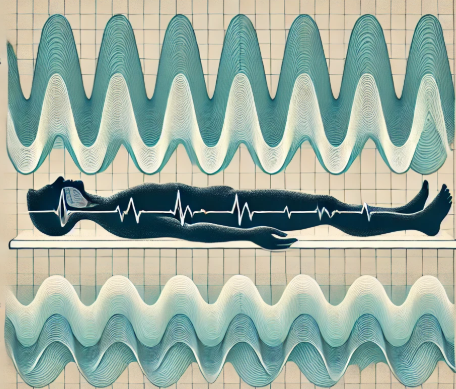Cheyne-Stokes Breathing (CSB) is an unusual respiratory pattern characterized by a gradual increase in airflow followed by a period of apnea or no breathing.
This process repeats itself in a cyclical manner. Basically, the person experiences cycles of deeper, sometimes faster breathing followed by temporary pauses or reduced breathing.
The goal of this article is to provide a comprehensive understanding of Cheyne-Stokes, exploring its causes, symptoms, and potential treatments while addressing its implications for health, particularly in the elderly.
By equipping readers with knowledge about this condition, the article aims to foster awareness, encourage early recognition, and guide individuals and caregivers toward effective management strategies to improve quality of life and ensure appropriate care.

Understanding Cheyne-Stokes Breathing
While it may appear as a harmless quirk in respiration, this rhythmic cycle often signals underlying health challenges that require medical attention. Commonly seen in individuals with conditions such as heart failure, stroke, or neurological disorders, CSB also becomes more prevalent with advancing age as the respiratory system weakens.
In some cases, it may appear during the end stages of life, raising questions about its role as an indicator of declining health.
Understanding this irregular respiratory condition—its causes, symptoms, and management options—can be crucial for caregivers and healthcare providers, especially when supporting the elderly or those with chronic illnesses.
During the hyperventilation phase, breathing becomes increasingly deeper and rapid. Then comes apnea, a moment when breathing temporarily stops altogether. This pattern is more than just peculiar; it can indicate underlying medical issues that might need attention.
Recognizing this is important because it often serves as a red flag for health problems needing more than just routine checkups. Knowing what to look for could be a big step towards addressing broader health concerns.
CSB is not just another breathing hiccup; it’s a window into understanding potentially serious health challenges that might be lurking beneath the surface.
Causes and Risk Factors of Cheyne-Stokes
Cheyne-Stokes often shows up alongside certain medical conditions. There’s a higher chance CSB might occur if you or someone you know is dealing with:
- Heart failure.
- Stroke.
- Or neurological disorders.
These conditions can disrupt how your body regulates breathing, leading to the characteristic breathing rhythms that define CSB.
Aging adds another layer to this. As we grow older, our respiratory system naturally weakens, making it harder for some to breathe efficiently. This decline in respiratory efficiency can make older adults more susceptible to experiencing abnormal breathing patterns.
Understanding these causes and identifying risk factors can help in managing and, possibly, preventing the complications associated with Cheyne-Stokes . Keeping an eye on these conditions and maintaining regular health check-ups can go a long way in managing the risk of developing CSB.
It’s always a good idea to have a dialogue with healthcare providers if there are concerns about breathing patterns, especially in those with existing health issues or advancing age.
Recognizing and Diagnosing CSB
Identifying this condition might seem tricky, but certain tell-tale signs make it distinguishable. The pattern involves progressively shallower breaths, eventually leading to pauses or even brief moments where breathing stops altogether.
This might resemble a regular cycle of increasing then decreasing breathing efforts, followed by a pause.
To effectively diagnose this, medical professionals often turn to tools like polysomnography, which is a comprehensive recording of biophysiological changes that occur during sleep.
This test can reveal the tell-tale cycles. Blood tests might also be conducted to rule out other possibilities and pinpoint exact causes.
Imaging tools, such as X-rays and MRIs, can help get a clearer picture of what’s happening internally. These diagnostics are vital, as this can sometimes point to more serious, underlying health issues.
Recognizing this pattern early on is key to managing it effectively. If you’re worried about how someone breathes, especially during sleep, it might be time to consult a healthcare provider. They can guide you through the necessary steps to manage this condition before it escalates.
Effective Treatment and Management
Start by looking at underlying health issues. Treating related conditions like heart failure or neurological disorders can sometimes alleviate the breathing pattern itself. Medical professionals might focus on these root causes to bring about improvement.
Oxygen therapy and Continuous Positive Airway Pressure (CPAP) devices are commonly recommended for symptom management. These therapies help maintain steady airflow by ensuring a constant supply of oxygen or keeping airways open during sleep, reducing the occurrence of apnea.
Medications can also play a role. Doctors may prescribe drugs that improve overall heart function or stabilize breathing patterns to tackle the problem at its core.
Lifestyle changes shouldn’t be overlooked either. Encouraging healthy habits like regular exercise, proper diet, and avoiding smoking can support better respiratory health. Such adjustments can be an essential part of a comprehensive management plan.
If CSB symptoms are present, a discussion with a healthcare provider can help tailor a treatment approach that addresses both the immediate and long-term health.
Taking action early can make a significant difference in managing the condition effectively. By focusing on comprehensive treatment plans that address both symptoms and underlying causes, individuals and their families can work towards better health and quality of life.
Conclusion | Irregularity in Respiration
Cheyne-Stokes is more than a simple irregularity in respiration—it serves as an important indicator of potential underlying health issues.
While its presence may be associated with serious conditions such as heart failure or neurological disorders, effective management can significantly improve the quality of life for those affected.
Essential steps toward mitigating the impact of CSB are:
- Identifying the signs.
- Seeking early medical intervention.
- And addressing the root causes.
For caregivers and families, understanding this condition is particularly critical when caring for elderly loved ones or those with chronic illnesses.
Whether CSB occurs as part of a treatable medical condition or during the final stages of life, compassionate and informed care can make a meaningful difference in addressing the challenges it presents.
So, there you have it: “Cheyne-Stokes Breathing Definition – End-of-Life Symptom?”
We hope this article has shed light on this unique breathing pattern and its implications. Whether you have personal experiences, insights, or questions, we’d love to hear from you.
Feel free to share your thoughts or ask any questions in the comments section below. Your input not only helps foster a supportive community but can also provide valuable perspectives for others who may be dealing with similar concerns. Let’s start the conversation!
Veron | Entrepreneur | The Way 4WordEnterprises
